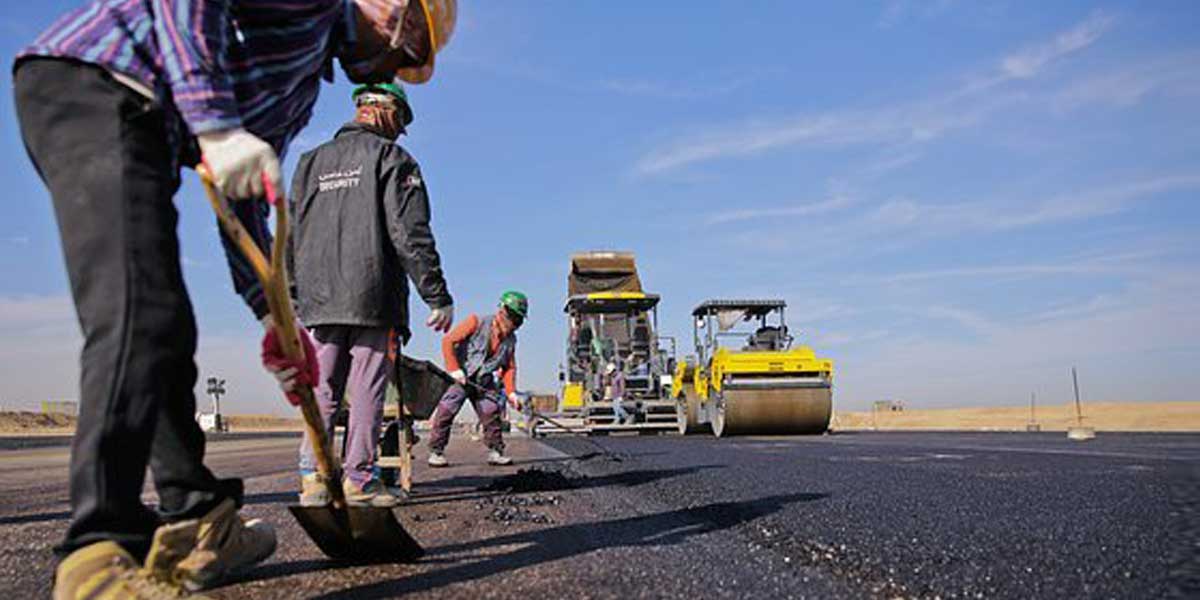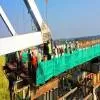Traffic demand increases with increase in population. New pavements with adequate quality
and sufficient strength to bear the increased traffic loads are required to cater to this demand.
Pavements are constructed using different layers, and the strength of the different layers of
the pavement is an indicator of the pavement's structural capacity and influences its service
life. The materials in different pavement layers are compacted mechanically using different
rollers to attain the desired compaction level. A single-drum vibratory roller is used for
cohesionless material such as sand and crushed rocks whereas a sheepfoot roller is used to
compact cohesive or fine-grained soil such as clayey and silty-clayey soils; in case of asphalt
compaction, a double-drum vibratory compaction roller is used.
After the material is compacted, the compaction process's quantification is done using the in-
situ state, such as material density and modulus. When the material is compacted, the
compaction process reduces the air-void content, increases material density, and provides
better interlocking between materials. It also increases the load-bearing capacity, prevents
settlement and reduces water seepage. Inadequate and non-uniform material densities are
identified as a reason for premature pavement failure, including potholes and rutting along
the wheel path. These failures lead to significant costs in maintenance and rehabilitation. For
example, building each lane-mile of road costs between $ 4.2 and $ 15.4 million; it costs $
24,000 a year to maintain.
Quality assurance (QA) and quality control (QC) for adequate density and modulus are done
using different methods including nuclear gauge, fixed volume extraction method, falling
weight deflectometer (FWD) and sand replacement test. The fixed volume extraction method
and sand replacement, which involve sampling, are lag indicators; it can take from two to
seven days for the results to be available and they are often not favoured by field practitioners
who want to lay another layer of materials as soon as possible. Non-destructive techniques,
such as nuclear gauge and FWD, are spot-based measurements that do not cover the entire
area. The major drawback of all conventional tests is that they can only be done after
compaction is over.
Thus, intelligent compaction (IC) technology is becoming popular to overcome the problems
mentioned above. IC in pavement construction is capable of monitoring compaction quality
in real time, non-destructively.
Understanding IC
IC is an innovative technology that instruments the traditional roller with advanced devices
such as radio, receivers of GPS and an accelerometer to perform the compaction process. The
use of GPS helps track the roller's movement in both horizontal and longitudinal directions,
which gives feedback to the operator about the number of passes completed. An
accelerometer helps quantify the material's response as it is compacted, and the acceleration
signature of the material is related to the material compaction state. In the case of asphalt, the
temperature plays a vital role in the compaction's effectiveness. The surface temperature can
also be recorded using a thermal infrared sensor.
The collection and analysis of data from all the sensors are done in real time using the
onboard PC, and the results are displayed in the operator's interface through colour-coded
maps. The maps include the total number of passes and acceleration signature. The color-
coded map helps the operator visualise and get feedback in order to then adjust the roller
parameters such as applied force and drum frequency to obtain an effective and efficient
compaction process in real time. Researchers are also working on adjusting the roller
parameters automatically.
Origin of IC
The idea of IC was initiated and developed in 1974 when the real-time measurement of the
drum's acceleration was used to evaluate the degree of soil densification; it was known as
continuous compaction control (CCC). Following some early developments during the 1970s,
technology was officially introduced to the scientific community at the First International
Conference on Compaction held in Paris in 1980. Later, various roller manufacturers
developed different types of measurement systems based on accelerometer readings. After
realising the enormous potential of the technology in enhancing conventional compaction
methods, several road authorities, including the Federal Highway Administration (FHWA),
have accelerated their attempts to promote the use of the technology.
Analysis of acceleration signature
Different roller manufacturers have developed different methods of analysing the acceleration
signature collected from the accelerometer. Intelligent Compaction Measurement Value
(ICMV) is the common term for all such accelerometer-based vibration measurement
systems. ICMVs include Compaction Meter Value (CMV) developed by Geodynamik and
Dynapac, Vibratory Modulus Value (E VIB ) developed by BOMAG, Roller Integrated Stiffness
(k B ) developed by Ammann, and Compaction Control Value (CCV) developed by Sakai.
Clayey soils, which do not respond to vibration well, are compacted using sheepfoot rollers
that do not use vibration. So, in clayey soil, Machine Drive Power (MDP) is used, which is an
indirect indicator of the power needed to move the machine.
The ICMVs mentioned above are then correlated with conventional test methods such as ND,
FWD and Plate Load Test (PLT).
Advantages of ICThe pavement will perform better as we can ensure uniform compaction throughout
the pavement.
Each lift of compaction is recorded continuously.
Destructive tests and spot tests can be eliminated.
There are no chances for human (operator) error because the compaction process is
monitored in real time digitally; this is also useful during low visibility, especially at
night.
The roller’s life is improved as vibration and mechanical loads are controlled
automatically and the fatigue of the roller is reduced.
Overcompaction is avoided and weak spots (undercompacted areas) can be detected
and corrected before compacting subsequent layers.
The database can be used for future documentation and related to the service life of
the pavement.
Disadvantages of IC
The initial cost is high compared to the existing compaction method because of
additional instrumentation and required training of the roller operator.
IC does not directly measure the modulus of the compacted layer or density of the
compacted material. Instead, the ICMVs have been correlated with density and
modulus. The correlation between ICMVs and in-situ values are still not very good.
As the IC roller uses an onboard computer system and records massive data, a crash
of the system can lead to a huge problem. Data analysis and data transfer should be
done frequently to avoid this issue.
Acceptance of IC
The US, Europe and China are some places where IC has been accepted. In other countries,
adoption is still in the early stages and industries are reluctant to use the technology because
of its drawbacks. The construction industry faces several uncertainties and concerns, such as
its usefulness in terms of costs and benefits.
With the advent of big data and sophisticated instruments at low prices, IC is now heading
towards a better correlation of ICMVs and in-situ values, which reduces the uncertainties
regarding its usefulness and initial cost. Hopefully, these will help other countries use IC for
the compaction process.
About the authors: Amir Tophel is a PhD scholar, ARC Smart Pavements Hub - SPARC,
Department of Civil Engineering, Monash University, Australia. Priyansh Singh is
Assistant Professor, Department of Civil Engineering, Indian Institute of Technology –
Indore.


















